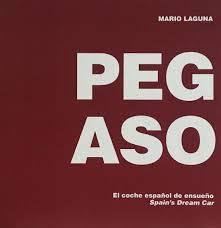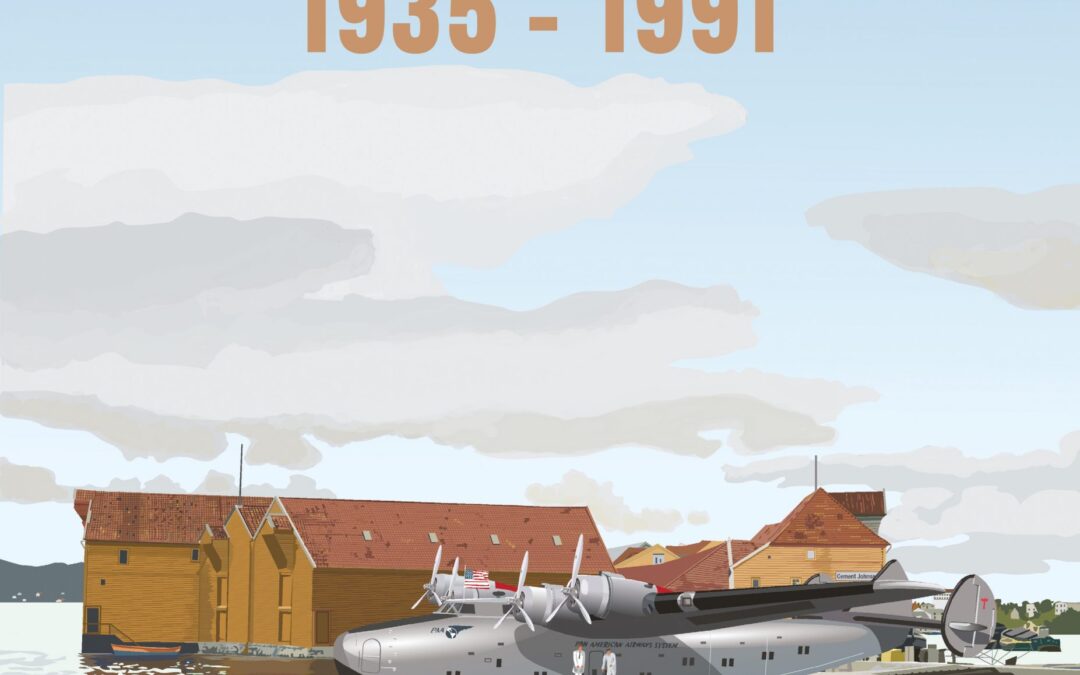
A softback book of 76 pages about the trials to open an air service between Norway and the USA. One’s the world’s largest airlines with a network spanning the world: Pan American Airways. The history of this airline is without doubt very interesting. A service to the small country of Norway was just one of the air services operated, but generated some 30,000 to 50,000 passengers per year. In this special magazine, we take a look at the history of Pan American World Airways and its routes to Norway.
How diverse its history is can be understood, when we ask you the following question: when was the first air service to be inaugurated: 1936? 1940? 1946? You might be interested to know that Pan American Airways as early as the 1936 wanted to start a trial service and in 1940 actually an air service, but it had to wait until after the Second World War. Its fascinating story is told here, all the way until the end in 1991.
The author describes the intense conversation between the Nordic airline companies and Pan American Airways before the war and gives a historic detailed description of the post-war development, including many photographs, timetables, posters and advertisments from that time. Pages are dedicated to marketing and sales, the Oslo office and its two most well-known directors: Derek L Blix and Berit Sjølund. A final chapter describes the work of the World Wings International, the Norwegian Chapter, the association of former Pan Am stewardesses. The softback magazine includes a beautiful painting of the Norwegian Sikorsky S-43, LN-DAG “Valkyrien”. Plenty to read and look at.
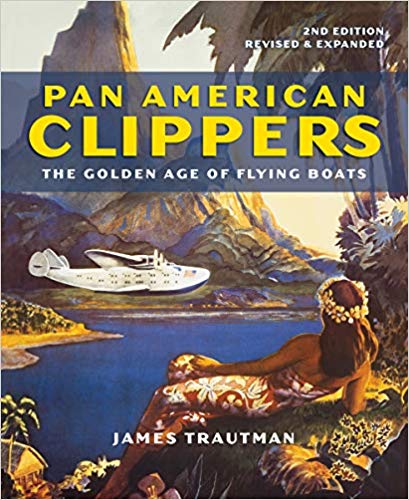
The photographs and artwork will enable readers to grasp the magnificence of the transoceanic flying boats…The accurate, authoritative text will provide information that is new to all but the exceptionally well-informed aviation buff and nonspecialist historian.”
–Choice
For a world recovering from the Great Depression, the Pan American Airways Clipper symbolized luxury, adventure and a brighter future. Illustrated with rare period photographs, vintage travel posters, magazine ads and colorful company brochures, Pan American Clippers covers all aspects of the Golden Age of Pan American’s graceful “flying boats.”
This edition has an additional 16 pages to add more historical and current information and provide additional detail and context to the historical importance of the flying boats, including:
- Pan Am’s Art Deco terminals
- the fate of the last Pan Am Clippers and where to see the survivors
- the Foynes Flying Boat Terminal, Ireland
- Trippe and Lindbergh’s groundbreaking flight to Asia by way of the Great Circle Route (Canada-Alaska-Siberia-Japan-China)
- Shediac, New Brunswick, landing site of 24 Savoia Manchetti S-55 flying boats from Rome en route to Chicago’s Century of Progress International Exposition
- Pan Am enters politics when Frank Roosevelt uses it in Latin America to sidestep the World War II Neutrality Act
- Trippe’s long-held dream of flying mail and passengers across the Atlantic Ocean to Europe, and the opening of LaGuardia Airport.
Visionary Pan Am founder Juan Trippe knew the importance of international travel to the 20th century, and his pioneering airline played a central role in the advancement of transoceanic flight, setting overseas time and distance records, providing airmail delivery and eventually as troop and cargo transports for the Allies during World War II. By dramatically reducing travel time and opening up international air travel to the general public, Pan Am Clippers forever changed the world.
This captivating, informative and richly illustrated book takes readers back to a time of glamor, romance and progress, when dreams once thought impossible were suddenly a reality.
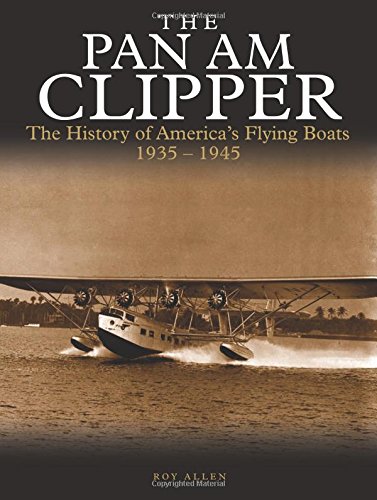
The history of Pan American Airways is, to a great degree, the story of international air transport and, within that, the flying-boat is one of the airliner’s most recognizable aircraft.
The Pan Am Clippers, as the Boeing B-314s, Sikorskys and Martin M-130s were known, were probably the most romantic planes ever built. The experience of flying in them was intended to rival the great ocean liners that had previously been the only way for passengers to cross the globe. Sleeping berths, lounges, silver goblets and meals on real china served by white-coated stewards were all part of the Clipper experience.
The Pan Am Clipper covers one of aviation history’s most inspiring and magical periods. Illustrated with more than 100 archive photographs, this impressive book is a tribute to a technical wonder that continues to fascinate and captivate many people today.

The Pan American clipper ships of the 1930s and 1940s were technological marvels of their time. The years before World War II found the United States faced with international challenges of an economic as well as a military nature. Aided by government regulations and contracts, the Pan Am clippers were, for a time, the only international craft to carry the U.S. flag. Commercially, they rivaled the comfort and popularity of passenger trains and luxurious cruise ships. Militarily, they were unmatched by anything the Germans, Russians, Italians or French could produce. The only long-range aircraft capable of carrying transoceanic payloads, clippers became instantly valuable with the onset of the war. Marketed as the ultimate in commercial–or military–airfare, these flying boats became as much an American icon as the Pan Am logo itself. From the movie screen to the bookshelf, this volume examines the multitude of ways in which the values inherent in Pan American Airways’ clipper ships played out in popular culture. The book discusses the strategies Pan Am used to represent the clipper as a paragon of U.S. interests, values and beliefs. Mirroring the moods of the times, the clipper became a consistent American icon, being associated with the Statue of Liberty and the American eagle. The main focus of the work is the variety of ways in which this iconographic status manifested itself through toys, movies, pulp fiction, comic books and music. Clipper influence is also examined in other unlikely places such as the name of an available car color, car models, restaurant menus and lounge names. An appendix explains different models of the clipper flying boats.
Pan Am
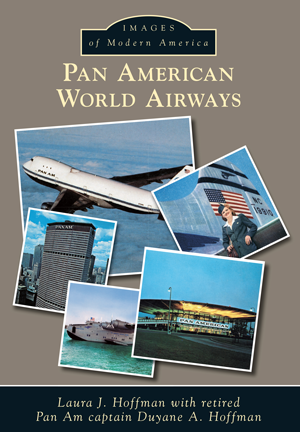
In 1927, American entrepreneur Juan T. Trippe founded what would later become Pan American World Airways, one of the world’s most prominent airlines of the 20th century. From the very first airmail flight flown from Key West to Cuba, Trippe provided leadership and innovation that put Pan Am at the top of the commercial airline industry. His global pioneering spirit expanded the world’s reach for the masses while at the same time provided the most glamorous of air-travel experiences. The rise and fall of an American empire is examined in this full-color postcard history of Pan Am.

2nd Edition
This officially licensed 120th anniversary edition of Indian Motorcycle tells the complete story of Indian Motorcycle, America’s first mass-produced motorcycle maker, from its start as a bicycle manufacturer to the purchase of the brand by Polaris Industries in 2011 and the subsequent new Indian motorcycles—updated to include new photography, the story of the latest models, including the FTR1200, Chieftain, Challenger, and Roadmaster, and Indian Motorcycle’s return to racing.
In the early years of the 20th century, Indian Motorcycle dominated the world’s racetracks and showrooms, earning the brand a worldwide reputation for quality, performance, reliability, and technical innovation with such classic machines as the Chief, Scout and Four. But the once-mighty company fell on hard times and in 1953 was forced to file bankruptcy.
The Indian Motorcycle brand never quite died, however, thanks in large part to fanatically devoted enthusiasts, who tried to resurrect it for over half a century. Finally, Polaris, maker of the highly regarded Victory brand of motorcycles, purchased the brand and released the Chief and Scout, models that once again restored Indian Motorcycle to its rightful place in the motorcycle pantheon.
Indian Motorcycle is the most complete and up-to-date history of this classic American motorcycle.
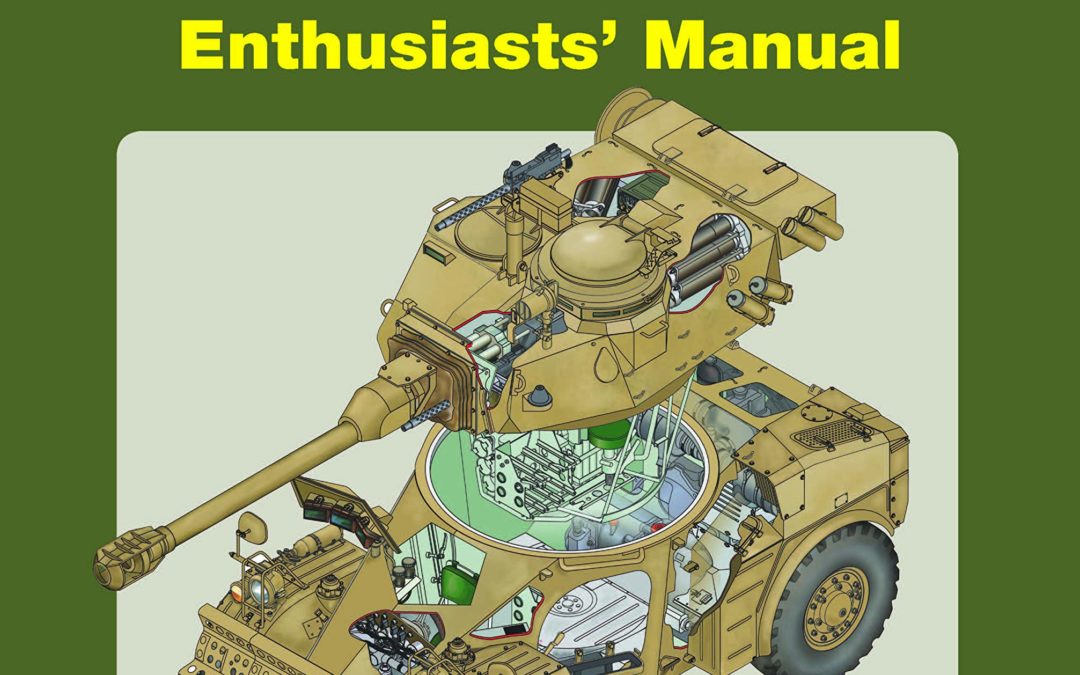
Enthusiasts Manual
Based on the British Ferret armoured car, the French-built Panhard AML was first used in combat during the war in Algeria in the early 1960s. Thereafter the AML has fought in numerous wars, notably in Africa, up until the present day with ongoing operations against Boko Haram in Nigeria and Chad. It also fought on the side of the Argentinians during the Falklands War in 1982, and the war on ISIS in 2016. Now with an experienced military author, who was given full and exclusive access to an AML armoured car, this is the latest modern armoured fighting vehicle to receive the Haynes treatment. The Panhard Armoured Car Enthusiasts’ Manual is fully illustrated with archive photos, technical drawings and detailed photography.
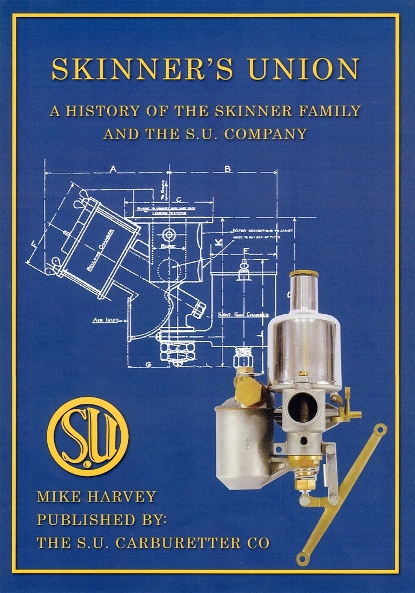
Skinner’s Union – A history of the Skinner family and the S.U Company is a comprehensive history of the S.U. Company and the members of the Skinner family involved. This new book by Mike Harvey comprises over 300 pages with copious photographs, drawings and illustrations (many not previously published).
The book’s main focus is on the period from 1908 when the leather bellows carburetter,designed by George Herbert Skinner, was first put into production by his younger brother Thomas Carlyle Skinner (whilst originally a partner in the firm of George Wailes & Co), through to Carl Skinner’s retirement in 1947, by which time the S.U. Carburetter Company Ltd was part of the vast Nuffield Organisation.
Two chapters cover Barbara and Peter Skinner’s hill climbing and racing activities and give details of the Skinner Specials. Another chapter covers the period leading up to and during WW2, when SU manufactured the aero-carburetters and single point injection systems for many RAF aircraft. During the Battle of Britain in 1940, the Rolls-Royce Merlin engine in every Spitfire and Hurricane had an SU Carburetter. Two Appendices cover the the history of the company from the 1950’s to the present day and list the main S.U products from the first prototype carburetter of 1904 through to 1994 when the original company ceased manufacturing the KIF carburetters for the Rover Metro. A further Appendix lists details of the original patents and drawings.
21183
20879
20756
20429
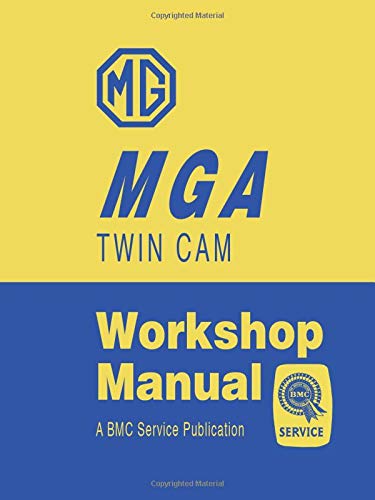
Factory shop manual for the MGA twin cam cars
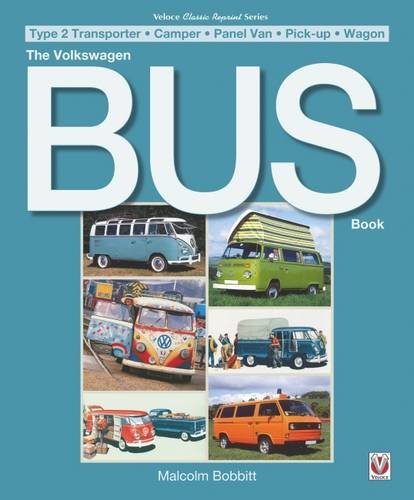
This is the story of VW’s timeless classic, the Type 2 Transporter, universally known as the “Bus”. It is sixty years since the idea of VW’s Transporter was conceived by Dutchman Ben Pon after seeing motorized trollies conveying components around the British-managed Wolfsburg factory in the mid-1940s. With blueprints complete by November 1948, the “Bulli” as it was known in Germany went into production a year later. The 100,000th Transporter was built in October 1954, the millionth in 1961 and the 3 millionth in 1971, the total number of vehicles exceeding 6.5 million. The Transporter changed little in concept throughout decades of production, and remained in production in Brazil until very recently, nearly six decades after its postwar German debut.
Researched in incredible detail, this book explores the story of the VW bus, from early origins through to the present day. This entirely new edition includes details of many of the different camper conversions, and examines the social history and the T2’s evolution. Including full specifications, production figures and buying advice, this totally reworked classic is an interesting, highly informative read and a must for any VW enthusiast.
Panel Beating & Body Work

Indian Motorcycle(R): America’s First Motorcycle Company(tm) tells the complete story of Indian, America’s first mass-produced motorcycle maker, from its start as a bicycle manufacturer to the purchase of the brand by Polaris Industries in 2011 and the subsequent new Indian motorcycles. In the early years of the 20th century, Indian dominated the world’s racetracks, earning the brand a worldwide reputation for quality, performance, reliability, and technical innovation, but the once-mighty company fell on hard times and in 1953 was forced to file bankruptcy.
The Indian brand never quite died, though, thanks in large part to fanatically devoted enthusiasts, who tried to resurrect it for over half a century. Finally Polaris, maker of the highly regarded Victory(R) brand of motorcycles, purchased the brand and released the Chief(R) and Scout(R), models that once again restored Indian to its rightful place in the motorcycle pantheon.
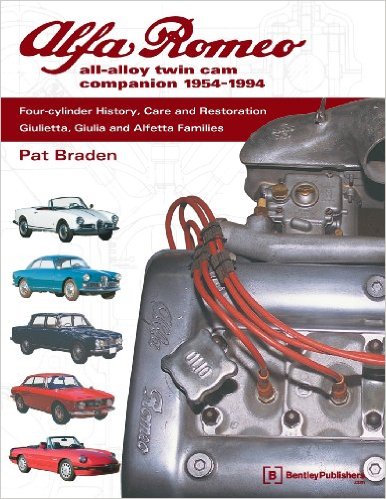
Alfa Romeo All-Alloy Twin Cam Companion provides an excellent technical and historical overview of the Giulietta and Giulia family of small sporting roadsters, coupes and sedans. If an Alfa Romeo had one of the all-alloy four-cylinder engines and reached production, it’s covered in the Alfa Romeo All-Alloy Twin Cam Companion. That means that even after the Giulia name was dropped – particularly in the United States – the many variants of Duetto, GTV, Berlina and Alfetta are covered, from 1954 through 1994 when the final Alfas-including the four-cylinder Spiders-were sold in the United States. When it came to Alfa Romeos, author Pat Braden was an enthusiast’s enthusiast. Pat didn’t just write about Alfas – he lived and breathed Alfas. From the mid-1950s when he first owned a Giulietta Sprint until his death in August 2002, Pat had owned scores of Alfa Romeos, ranging from a 6C 1750GTC and an 8C 2300 to 1900s, Giuliettas, Giulias and countless later models. Alfa models are discussed according to history, engine, chassis and trouble spots. Without being a repair manual, this book contains important technical information needed to understand and enjoy one of these Alfas, as well as to perform many minor repair, maintenance, and service tasks. Braden starts with a brief overview of Alfa Romeo history, followed by a look at Alfa’s presence in America. He also explores the major models of coupe, spider and berlina that used the all-alloy four-cylinder, as well as the limited production variants. Of course, he also gives much attention to that mighty engine itself. Braden explains the design and history of the engine, as well as exploring trouble spots and offering extensive advice and tips. Additional technical sections focus on the fuel system, transmission, brakes and chassis, not to mention overall restoration. Alfa Romeo All-Alloy Twin Cam Companion is a key to getting the absolute maximum benefit and enjoyment out of Alfa.
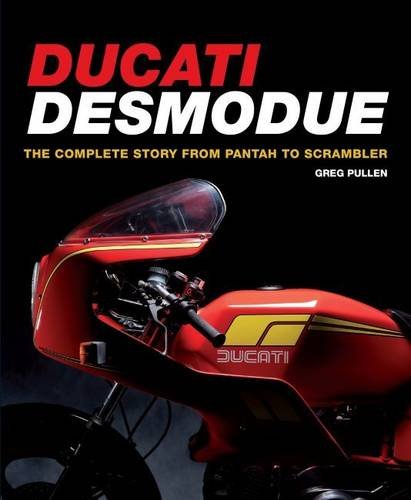
A definitive account of the popular Ducati Desmodue – the reliable, affordable, high-performance motorcycle range that boasts one of the most successful Italian motorcycles of all time, the Ducati Monster, and is still in development today.
Including full production histories, comprehensive specification details and owners’ experiences, this new book covers:
A history of Ducati and the rise of the brand in the 1970s
Grand Prix racing with Fabio Taglioni’s desmodromic valve engine design
The world-beating TT2 and TT1 racers
Ducati’s virtual swansong and the Cagiva takeover
The best-selling Ducati Monster – the ‘naked’ desmo twin
The Desmodue 900SS and the SportClassic range
Racing today, the new Ducati Scrambler and the future for Desmodue motorcycles






